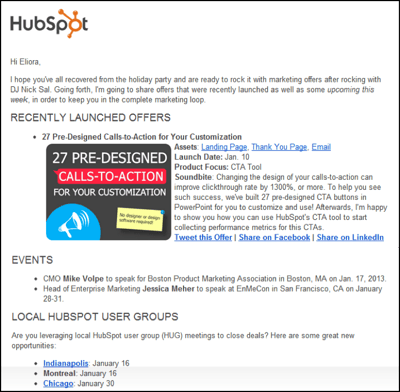Inside Out: The Emotions of Implementing Inbound Marketing
The thought of writing this post initially left me with a mild panic attack. After all, my audience consists of marketers, yes - but it also consists...
4 min read
 Jenna Orrock
Feb 15, 2017
Jenna Orrock
Feb 15, 2017

SMarketing, sales and marketing alignment, is critical to your manufacturing organization’s success. Both teams are responsible for your company’s growth and success. Both can now be held accountable for their contributions to revenue, and the gap between the teams has closed. With sales and marketing working close together, it’s critical that they work well together.
But can you confidently say that you know exactly what is happening with the leads after they kick over to sales? Do you know how leads are getting to your site in the first place, or why they're there?
 Test it out with the following questions. Do all of your team members, from both marketing and sales teams, know the answers to them?
Test it out with the following questions. Do all of your team members, from both marketing and sales teams, know the answers to them?
Chances are high that either your marketing team or your sales team know the answers to these questions. Very rarely are both teams on the same page.
So, this stat probably comes as no surprise to you: 87% of the terms sales and marketing use to describe each other are negative. But it doesn’t have to be that way. That’s why these teams have to work together within their own organization. Sales and marketing must collaborate.
Collaboration of the sales and marketing teams boils down to one thing, no matter which way you slice it. Sales and marketing are two halves of the same team: Team Revenue.
So, how do you do this? I’ve broken it down into 5 steps.
The first step to establishing sales and marketing alignment is to define the buyer funnel. Working with key marketing and sales stakeholders, make sure to clearly outline each team’s role in the funnel. In this example funnel, the first two stages are marketing’s responsibility. The third and fourth stages are split between sales and marketing. The fifth and sixth stages are entirely sales’s responsibility.
Only 25% of leads are legitimate and should advance to sales.
Setting up a funnel helps sales and marketing teams identify when to pass leads over to sales. SMarketing provides marketing with the opportunity to assess leads and provides insight into what happens to them after they pass them to sales so they can see what it is happening and adjust their efforts accordingly.
It’s hard to believe given the immense benefit of doing so, but 68% of B2B organizations haven’t identified what their funnel looks like.
You can’t be on the same team if you don’t know how you can move the needle. Step one needs to be setting up a funnel and making sure everyone within the organization is on the same page in order to have any kind of collaboration. Otherwise, you are setting your organization up for failure.
A Sales-Marketing SLA defines what each team commits to accomplishing in order to support the other in reaching the shared revenue goal(s). Marketing commits to delivering a certain quantity and quality of leads to help their sales team hit their quota.
And sales commits to follow up on those leads in a timely manner and make a specific number of contact attempts before abandoning the lead. There are a number of key metrics that can be tracked, and an SLA crystallizes the alignment around the goals. Once there is an agreement, both teams can work with passion and purpose to meet and surpass well defined goals.
SLAs pave the way for more pre-call information and therefore sales reps are more likely to research and get to know their lead before reaching out to them.
The next step is to set up closed-loop reporting. This ensures that there is proper feedback between sales and marketing.
Benefits for Marketing
Benefits for Sales
Each of these benefits are real and can be measured. Closed-loop reporting allows you to:
The previous three steps have all had a common theme: the focus on data. The key for SMarketing to work is to rely on that data. Aristotle said that the law is reason free from passion. We would restate it to say that SMarketing is data free from emotion.
Dashboards are an important part of capturing and reporting data. In addition, it’s really helpful to do a monthly SMarketing report. This can be an official document, a powerpoint deck that is sent over email, or it can take the form of a monthly in person meeting – where marketing and sales both report on their past month’s performance.
Here at Trending Up, we do this on a weekly basis, with a deeper dive monthly and quarterly to view longer-term data. The SMarketing report should dig into all the important metrics like your SLA as well as your other funnel metrics. You should evaluate and share why both marketing and sales did or did not hit targets.
Besides sharing your stats in a monthly meeting for your sales and marketing teams – leaders in both your sales and marketing teams should come together for an in-person meeting to get on the same page about team successes, product information, persona education and SLA waterfalls.
This is a time where you can look at your shared dashboard and address any concerning trends – this opens the conversation up everything from lead flow and quality, to hiring plans for your sales team.
Meetings cover major communication on a monthly basis. This is great, but it doesn’t solve for the day to day. Marketers should market your company’s campaigns to your sales team in emails and easy-to-digest formats as well.
Here’s an example of an email that shares recent campaigns, and ALL the info sales needs in order to be successful to follow up with leads who are converting on that campaign.

Because marketing needs to create collateral (web pages, spec sheets and so on) about updates to products and services, they’re in the know before sales – marketing should take the responsibility to train and arm the sales team with the details of these changes, and the positioning for why customers/prospects will care.
Only 30% of CMOs have a clear process or program to make marketing and sales alignment a priority. This is a huge opportunities for marketing and sales leaders to make a real change.
When sales and marketing teams are in sync, companies became 67% better at closing deals. And alignment of sales and marketing impacts revenue growth up to 3 times.
What are you waiting for?

The thought of writing this post initially left me with a mild panic attack. After all, my audience consists of marketers, yes - but it also consists...

One of the biggest frustrations I hear from business leaders and CEOs about marketing is the inability to draw a direct line from any one marketing...

Earlier this week, I wrote about why inbound marketing works for manufacturing. I walked through the buyer’s journey, from discovery, to...